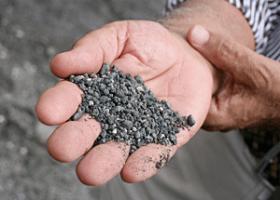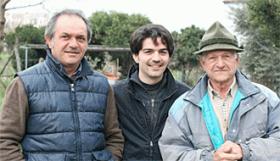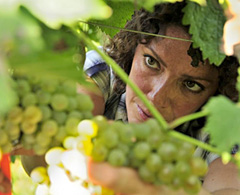| « Previous | News | Next » |
August 25, 2014
Fire Drinkers of Campania
In AD 79, one of the most infamous volcanic eruptions of all time buried the Italian city of Pompeii under a huge amount of lava and ash—at a hundred thousand times the thermal energy released by the bomb at Hiroshima—preserving the devastated city for centuries before it was discovered by archeologists over a thousand years later. Today, the volcano that caused this much destruction, Mt. Vesuvius, is snugly nestled only 9 miles from the city of Naples—meaning that over 3 million people are within 9 miles of one of the most dangerous—and still active—volcanoes in the world.
Though this may strike terror into the hearts of many, for some winemakers, it’s like striking gold. Several brave souls have set up camp right on the slope of the volcano to cultivate its vine-loving soils. Ancient, indigenous grapes like Falanghina can’t get enough of this land, which is porous and allows water to be retained and then drain deep into the subsoils. The dark color of the soils helps them absorb heat and provide a “re-radiation” effect at night, so the grapes get gobsmacked with flavor. Plus, volcanic soils are supercharged with minerals. All this adds up to truly unique wines made by winemakers dedicated to this terroir.
 Vincenzio Ambrosio is one of the brave. He, his wife Dora, and their son and daughters have been farming the soils inside Vesuvius National Park since 1997 under the Villa Dora label. Together with winemaker Fabio Mecca, they organically farm their 8 hectares of ground-pumice soils on the slopes of Vesuvius, at about 250 meters. Their winery is situated right alongside the vineyard, so the volcano is truly part of every step of production. They are located in Terzigno, about 3 km from Pompeii. Most of their vines are over 40 years old.
Vincenzio Ambrosio is one of the brave. He, his wife Dora, and their son and daughters have been farming the soils inside Vesuvius National Park since 1997 under the Villa Dora label. Together with winemaker Fabio Mecca, they organically farm their 8 hectares of ground-pumice soils on the slopes of Vesuvius, at about 250 meters. Their winery is situated right alongside the vineyard, so the volcano is truly part of every step of production. They are located in Terzigno, about 3 km from Pompeii. Most of their vines are over 40 years old.
Their 2011’ Vigna del Vulcano’ is an homage to the Roman’s great god of fire and volcanoes. Comprised of Coda di Volpa and Falanghina grapes, it is fermented in steel with no malolactic fermentation. The idea is to keep this juice as lively and expressive as fruit fresh off the vine. Underlying aromas of flint pervade the nose, with bright notes of chamomile and herbs on the palate. The medium-weight body carries nice acidity. Pair with white fish and fresh herb butter to bring out the herbal notes in the wine.
 Another winemaking family deeply connected to Vesuvius is the Di Meos, who have been making La Sibilla wine in the area for five generations. Luigi Di Meo and his two grandsons are currently at the helm. Luigi’s grandfather began farming the current estate—9.5 hectares of volcanic-formed ash and lapilli soil just north of Naples—with the help of his nine children in 1930. Because volcanic soil is naturally phylloxera resistant, the vines are completely ungrafted, grown from seed. Here, rainfall is scarce, but a salty marine breeze keeps temperatures low. (View La Sibilla introduction video.)
Another winemaking family deeply connected to Vesuvius is the Di Meos, who have been making La Sibilla wine in the area for five generations. Luigi Di Meo and his two grandsons are currently at the helm. Luigi’s grandfather began farming the current estate—9.5 hectares of volcanic-formed ash and lapilli soil just north of Naples—with the help of his nine children in 1930. Because volcanic soil is naturally phylloxera resistant, the vines are completely ungrafted, grown from seed. Here, rainfall is scarce, but a salty marine breeze keeps temperatures low. (View La Sibilla introduction video.)
Their 2012 Falanghina Campi Flegrei is light straw in color but expressive and vibrant with floral on the nose. The grapes are hand-picked and then taken immediately to the cellar to be destemmed and pressed. The whole process takes place in a temperature- and oxygen-controlled environment, then fermented with indigenous yeast. All this meticulous winemaking results in great minerality and lemony notes, with flourishes of salinity and wild flowers. Paired with frittata and salad, this small-production elixir— only 240 cases—makes a refreshing summer dinner.
 I Cacciagalli is a young, burgeoning estate in the northern region of Caserta, located at the foot of another volcano, this one extinct for at least 50,000 years: Roccamonfina. Their six acres of vineyards are surrounded by trees, water, and olive, hazelnut, and chestnut groves. It is owned by Mario Bosco and Diana Iannacone, a young agronomist who respects her family’s land by farming it biodynamically. Their sandy, calcareous volcanic soil is rich in potassium, a mineral that vines eat like candy.
I Cacciagalli is a young, burgeoning estate in the northern region of Caserta, located at the foot of another volcano, this one extinct for at least 50,000 years: Roccamonfina. Their six acres of vineyards are surrounded by trees, water, and olive, hazelnut, and chestnut groves. It is owned by Mario Bosco and Diana Iannacone, a young agronomist who respects her family’s land by farming it biodynamically. Their sandy, calcareous volcanic soil is rich in potassium, a mineral that vines eat like candy.
All of which may explain why their 2011 ‘Aorivola’ Falanghina is such a special breed. It’s rich and luxurious—a very earthy and soulful wine. If, as rumored, Falanghina really is an ancient grape, you get hints here of what might have made it so popular in Roman times. It shows a deep honey color in the glass, and exudes mineral, blossom, herb, and fresh straw notes. This estate-grown, unfiltered wine is made as naturally as possible: hand picked, then fermented with indigenous yeast and limited sulphur. It’s ponderous and beautiful. Pair with cheese, cheese, and more cheese.
The history of eruptions in the Campanian volcanic arc have laid the groundwork for some of the most exquisite whites coming out of Italy today—it’s no wonder that ancient wine-loving Romans worshiped Vesuvius as a power of Jupiter; they were prescient. With roots in ancient grapes and deeply complex soils, Campania today produces wines as passionate and fiery as the volcanoes whence they came. And if that’s not elixir fit for a fire god, then I don’t know what is.
